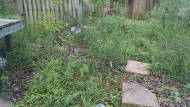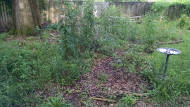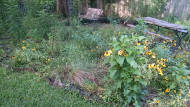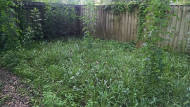A Better Sense of Place
2015 June 29 (Mon)
Overgrown but not forgotten
It has rained pretty consistently for the past month and a half. Not non-stop. Just frequently enough that the ground hasn't dried out. So the weeds are taking over. The St. Augustine grass is growing fast and tall and sending out stolons everywhere. Camphor, Chinese tallow, chamberbitter, low hop clover, and some crap exotic grasses are sprouting faster than I can remove them. There are a lot more dormant seeds in the yard than I expected. I can't imagine ever getting the yard to a state of natives consistently crowding out exotics.
Let's start with the previous picture. It's the "Grave Site" next to the back deck. It has a buttonbush, but it's also covered in sedge, basketgrass, deertongue, camphor, cherry laurel, asters, and whatnot. Off to the right is the trail that leads to the rain garden, hidden in grass, sedge, and asters. Here's another look toward the rain garden.
On the very left is a new patch of inland sea oats that I'm hoping is strong enough to one day begin spreading and crowd out all the other crap. But for now, there's a ton of white and purple asters — purple being the really tall stuff — that I'm unsure about keeping, but the fall pollinators rely on them and I've got nothing else for them right now. Underneath those tall guys are exotic spiderwort (not the native one), Virginia creeper, camphor, sedge, deertongue, straggler daisy, crap grass, and unknown things. By the bird bath are the two Virginia sweetspires that are steadily becoming bigger. Let's move on though.
This is the annoying view from the other end of the rain garden. Black-eyed Susans have gotten leggy with nothing to rest up against except some of that purple aster stuff. There's a single Gulf muhly, some spikes of swamp sunflower (that will hopefully flower this year), more Virginia creeper, sedges, American nightshade, some intrepid milkweed of some sort, coreopsis dregs, a small tuft of inland sea oats, a stick of a buttonbush, and a whole lotta crap grass that's going to seed. The last thing is what's most irritating. I really need to reserve a large chunk of time, slather on bug-repellent, and get to weeding before the exotic seeds spread.
This last picture is of the Chicken Yard. Amongst all the flowerless lanceleaf coreopsis is a single coneflower flower. These plants may like shade (as the seed mix says: "Shade-Friendly Wildflower Mix" from Native American Seed) but they sure don't flower. At least not yet. In mid-April, I sowed a ton of shade-tolerant grass seeds, but it will take a couple years to see if that works. Otherwise, I have two red mulberries that are doing quite well, tall purple asters, sedges, straggler daisy, Virginia creeper, an eaten redbud, and an eaten oakleaf hydrangea. Long-term, I hope this area will be dominated by the red mulberry, but I'm not really sure how well they do in the shade of a live oak.
As has been the case this year, the alley is still the stand-out as far as successes. Right now, there are a lot of bushy partridge pea with some black-eyed Susans, coralbean, Maximilian sunflowers, and goldenrod. The last two will only bloom in late summer to mid-fall. Pollinators these days are mostly European honeybees from somebody's hive. Kinda sad, but I hear native bees, butterflies, and moths have really been taking a hit in recent decades due to habit loss. Much of the settled country is turfgrass that has no value. Prairies and forest are still being bulldozed, tilled, and paved. I don't know if I'm really making a difference or setting a good inspiring example for others. Especially with my lack of success.



